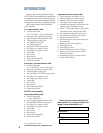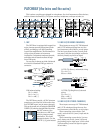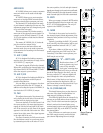
5
2. MAKE THE CONNECTIONS:
1. Connect your amplifier’s outputs to your
speaker inputs (unless, of course, you have
powered monitors).
2. Plug all the sound system components into
suitable AC outlets, properly grounded and
capable of delivering adequate current.
3. Using XLR or 1/4" TRS cables, make
connections from your mixer’s MAIN OUT
to your amplification system’s line inputs.
4. Make connections from your microphones
and instruments to the mixer: Connect
balanced microphones to the mono channel
MIC jacks. (For condenser microphones,
engage the PHANTOM POWER switch,
located just above the meters). Connect
line-level instruments (synthesizers, guitar
effects, direct boxes) to the mono or stereo
channel LINE IN 1/4" TRS jacks.
5. ZERO THE CONSOLE as shown on the
previous page.
6. Turn all the power switches on, leaving the
amplifier’s switch for last.
7. Turn up the MAIN MIX faders to the
“–30” label, for now. We’ll crank it later on.
8. Now you are ready to set the levels:
3. SET THE LEVELS:
1. Choose one of the microphones or instru-
ments you connected. Make some noise. If
it’s a microphone, sing at your normal
singing volume. If it’s a synthesizer, play it
at its normal output level.
2. While making noise, turn up that channel’s
GAIN control until the adjacent LEVEL
SET LED starts a-blinking.
3. Disengage (up) that channel’s MUTE.
4. Raise that channel’s fader to unity gain
(“U” label). You should be hearing your
noise now.
5. If necessary, apply channel EQ changes.
(You may need to compensate for level
changes with the channel fader.)
6. Check that the channel’s OL LED does not
come on. If it does, reset the GAIN and
adjust the EQ if required.
7. Repeat steps 1 through 6 for the remaining
active channels.
8. Stop making noise. Everyone: start making
music.
9. Now you are ready to tweak the mix:
4. TWEAK THE MIX:
1. Engage MUTE on all channels except your
rhythm section (drums & bass).
2. Adjust the rhythm section’s channel faders
to get a good balance of levels.
3. Un-mute the other active channels and
adjust their faders.
4. Now that you have a rough mix going, turn
up the MAIN MIX faders to a comfortable
listening level.
5. If the overall mix has an equalization
problem, make adjustments to the STEREO
GRAPHIC EQ. If an individual channel is
the problem, use its channel EQ instead.
6. Use the channel AUX 2/EFX knobs to send
signals to the EMAC internal effects
processor (and to any external effects
processor you might have). Then adjust the
AUX 2/EFX RETURN fader and experiment
with adding some effects to your main mix.
7. If you are playing into the CD/TAPE input,
try using the VOCAL ELIMINATOR to hear
its effect on centered vocals and start up a
bit of audience mass-Karaoke.
8. Depending on how much time you’ve got,
keep tweaking. Walk the room to see how it
sounds away from your mixer.
Keep tweaking.
KNOW THESE THINGS:
• Never listen to loud
music for prolonged
periods. Please see “Safety
Instructions” on page 2 for
information on hearing
protection.
• Never plug amplifier outputs into anything
except speakers.
• Never use guitar cables to connect amplifi-
ers to speakers.
• Before making connections to an external
amp or reconfiguring an amp’s routing, turn
the amp’s level (gain) controls down, turn
the power off, make the changes, turn the
power back on, and then turn the level
controls back up.
• When you shut down your equipment, turn
off any external amplifiers first. When
powering up, turn on the amplifiers last.
• Change your engine oil every 3,000 miles
and rotate your tires for even wear. Dad
would be proud of you.
• Save the shipping box and packing material!
You may need them someday, and you probably
don’t want to have to pay for that again.


















